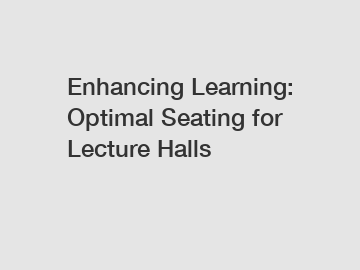Enhancing Learning: Optimal Seating for Lecture Halls
Enhancing Learning: Optimal Seating for Lecture Halls?
Have you ever wondered how seating arrangements in lecture halls impact student learning? In this article, we delve into the importance of optimal seating for enhancing the educational experience. From the position of the seats to the overall design, each aspect plays a crucial role in student engagement and knowledge retention. So, let's explore the topic in detail.
1. Seat Configuration:

The arrangement of seats greatly influences the learning environment. Traditionally, lecture halls have rows of seats facing the front, promoting a one-way flow of information from the lecturer to the audience. However, this setup may hinder student participation and interaction. By reconfiguring the seating layout into a circular or semi-circular shape, students can engage in discussions, collaborative work, and ask questions more easily. This enhances active learning, allowing students to contribute, share ideas, and build upon each other's knowledge.
2. Distance from the Lecturer:
The proximity of students to the lecturer plays a vital role in information absorption. Sitting too far away from the front can result in decreased attention and comprehension, especially for students with hearing difficulties. The optimal distance allows students to clearly see and hear the lecturer without straining. Adequate distance ensures that visual aids, such as slides or chalkboard writings, are visible to all, fostering a more inclusive learning environment.
3. Acoustic Considerations:
Alongside visual clarity, acoustic properties significantly impact students' ability to absorb information. Lecture halls should be designed with sound amplification systems to ensure that the lecturer's voice is audible throughout the space. Moreover, the arrangement of seats should take into account the acoustic properties of the room, enabling efficient sound distribution and minimizing echoes or sound distortions. A comfortable acoustic atmosphere aids concentration, preventing the loss of important information.
4. Comfort and Ergonomics:
Comfortable seating is crucial for fostering an optimal learning environment. Uncomfortable chairs can be distracting and may result in decreased focus and engagement. Lecture halls should be equipped with ergonomic seating that supports good posture and provides ample padding. Ergonomic chairs allow students to maintain their focus for longer durations, reducing the likelihood of physical discomfort or fatigue. Comfortable seating encourages students to remain attentive and actively participate in the learning process.
5. Visual Accessibility:
To ensure an inclusive environment, lecture halls should consider the needs of visually-impaired students. Providing designated seating areas with proper lighting and unobstructed sightlines is essential. Additionally, incorporating technology such as closed-captioning systems or assistive aids ensures that visually-impaired students can fully engage with the content. Optimizing visual accessibility creates equal learning opportunities and promotes a diverse and inclusive classroom atmosphere.
6. Technology Integration:
In today's digitized world, technology integration in lecture halls is becoming increasingly important. Seating arrangements should be designed with easy access to power outlets and charging stations, enabling students to use their electronic devices without constraints. Furthermore, integrating smart boards or display screens can enhance visual learning experiences. By incorporating technology into the seating design, lecture halls can adapt to the evolving educational landscape and provide students with the tools they need to succeed.
In conclusion, the seating arrangement in lecture halls significantly impacts students' learning experiences. Optimal seating configurations facilitate active learning, promote student engagement, and encourage collaborative work. Considerations such as seat configuration, proximity to the lecturer, acoustic properties, comfort and ergonomics, visual accessibility, and technology integration should all be taken into account when designing lecture hall seating. By prioritizing these factors, educational institutions can create an environment that maximizes learning outcomes and supports student success. So, next time you step into a lecture hall, think about the optimal seating arrangements and how they impact your educational journey.
If you want to learn more, please visit our website 3 Seater Hospital Stainless Steel Chair, public waiting long bench chairs, 3 seater waiting Black.


